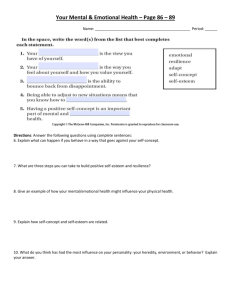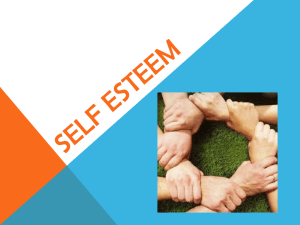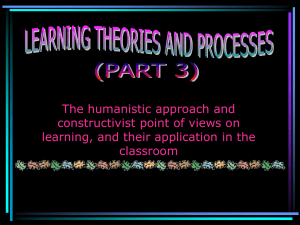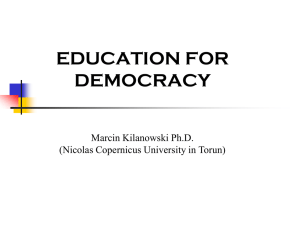here
advertisement
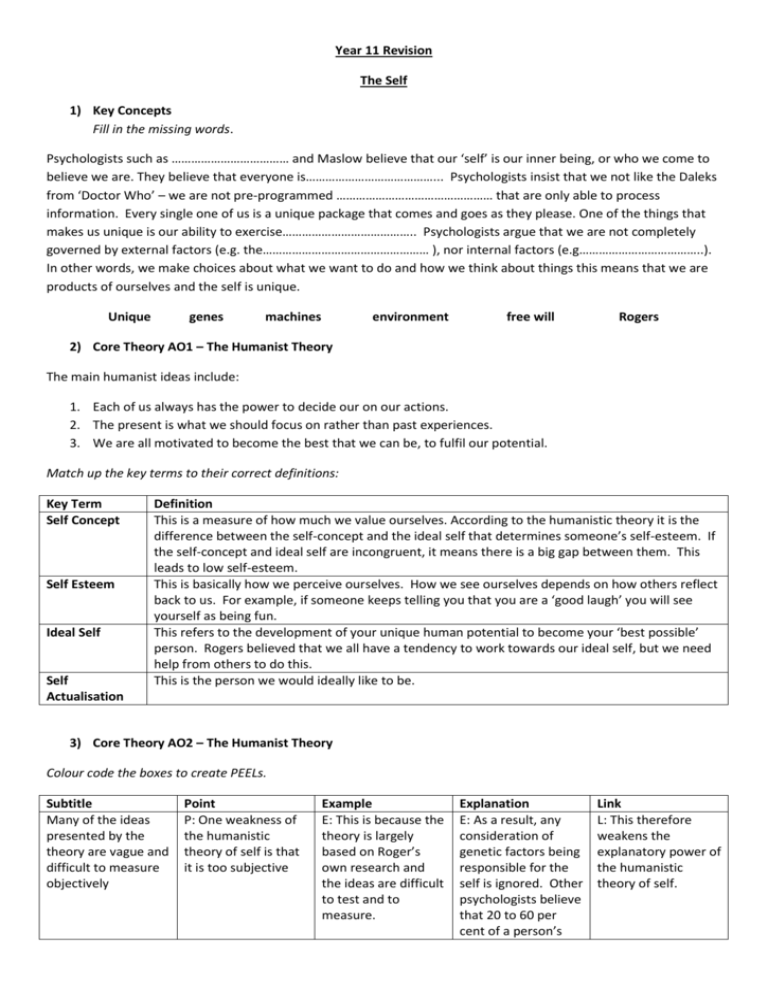
Year 11 Revision The Self 1) Key Concepts Fill in the missing words. Psychologists such as ……………………………… and Maslow believe that our ‘self’ is our inner being, or who we come to believe we are. They believe that everyone is…………………………………... Psychologists insist that we not like the Daleks from ‘Doctor Who’ – we are not pre-programmed ………………………………………… that are only able to process information. Every single one of us is a unique package that comes and goes as they please. One of the things that makes us unique is our ability to exercise………………………………….. Psychologists argue that we are not completely governed by external factors (e.g. the…………………………………………… ), nor internal factors (e.g………………………………..). In other words, we make choices about what we want to do and how we think about things this means that we are products of ourselves and the self is unique. Unique genes machines environment free will Rogers 2) Core Theory AO1 – The Humanist Theory The main humanist ideas include: 1. Each of us always has the power to decide our on our actions. 2. The present is what we should focus on rather than past experiences. 3. We are all motivated to become the best that we can be, to fulfil our potential. Match up the key terms to their correct definitions: Key Term Self Concept Self Esteem Ideal Self Self Actualisation Definition This is a measure of how much we value ourselves. According to the humanistic theory it is the difference between the self-concept and the ideal self that determines someone’s self-esteem. If the self-concept and ideal self are incongruent, it means there is a big gap between them. This leads to low self-esteem. This is basically how we perceive ourselves. How we see ourselves depends on how others reflect back to us. For example, if someone keeps telling you that you are a ‘good laugh’ you will see yourself as being fun. This refers to the development of your unique human potential to become your ‘best possible’ person. Rogers believed that we all have a tendency to work towards our ideal self, but we need help from others to do this. This is the person we would ideally like to be. 3) Core Theory AO2 – The Humanist Theory Colour code the boxes to create PEELs. Subtitle Many of the ideas presented by the theory are vague and difficult to measure objectively Point P: One weakness of the humanistic theory of self is that it is too subjective Example E: This is because the theory is largely based on Roger’s own research and the ideas are difficult to test and to measure. Explanation E: As a result, any consideration of genetic factors being responsible for the self is ignored. Other psychologists believe that 20 to 60 per cent of a person’s Link L: This therefore weakens the explanatory power of the humanistic theory of self. It is not scientific enough and not representative P: A criticism of the humanistic theory of self is that it ignore possible genetic factors. E: This is because by its very nature, the humanistic theory is all about the self and is too vague and difficult to measure objectively. The humanistic theory of self ignores genetic evidence. P: A further issue with the humanistic theory of self is that the theory is not very scientific and not representative. E: For example, there is a heavy focus on influence from our environment (nurture). The theory believes that it is only the influence of others that allows us to be able to fully selfactualise. intellectual, emotional and social development comes from genetic factors. E: This is an issue because although Rogers and other humanists would not want to be seen as scientific as they do not believe people should be studied scientifically, we cannot generalise any of the ideas to everybody because there is too much focus on individuality. E: This is an issue because people cannot easily study ‘yourself’ so it becomes difficult to establish what a person’s ‘ideal self’ is or how much they have ‘self-actualised. It is not a very scientific theory. L: This therefore reduces the explanatory power of the humanistic theory of self. L: This therefore reduces the credibility of the humanistic theory of self and Roger’s research as it is not representative of every individual. 4) Alternative Theory – Eysenck’s Trait Theory Rather than believing personality and the self are influenced by others and the environment (nurture), Eysenck believed that personality has: A genetic basis – we’ve been born that way A biological explanation – our personality is shaped by the activity of part of the mid-brain. This alternative ‘trait theory’ provides the following: A more scientific approach to try and measure personality more reliably Make more generalisations about people by recognising that we have traits in common with others Believe that our personality is more a product of genes than how others respond to us Fill in the diagram: ………………………………………….. the degree to which someone is outgoing and sociable ………………………………………….. ………………………………………….. being anxious or prone to mood swings, worried all the time being emotionally stable ………………………………………….. someone who is typically quiet and reserved 5) Core Theory AO1 – Van Houtte and Jarvis (1995) True or False? a. Van Houtte and Jarvis investigated the effect of playing sport on self esteem. b. They used a questionnaire c. They only used children from Scotland d. The children were ages 0-5 e. The participants were matched on marital status of their parents, socio economic status of the parents and number of siblings they had. f. They found that in general lower self-esteem was reported in pet owners than in non-pet owners. g. They also found that for 11 year olds, pets were found to positively influence self-concept h. Higher autonomy was reported by all pet owners across the age groups tested i. They concluded that pets may have the greatest impact on children’s lives as they move into adolescence. 6) Core Theory AO2 – Van Houtte and Jarvis (1995) Fill in the gaps using your own words Low internal validity P: A weakness of the study is that it may lack ………………………………………. validity. E: This is because Van Houtte and Jarvis used a self-report questionnaire method to investigate whether pet owners had higher self-esteem than non-pet owners. Pupils were asked to ………………………………………………………………………………………………………………………………………………………………………… ………………………………………………………………………………………………………………………………………………………………………… E: Consequently it may be difficult for children to have …………………………………………………………………………………………………. into aspects such as their self-esteem and self-concept and therefore the questionnaire might not measure what it set out to measure. L: Therefore, this weakens the ………………………………………………… of this research to support the notion of pets influencing the development of our self-esteem. Low population validity P: Another limitation of Van Houtte and Jarvis’ research into ‘The Self’ is that the research lacks ………………………………………………. validity. E: For example the …………………………………………… was only given to teenage pupils between the ages of 8-13. E: Although the sample size was actually fairly large (71 boys and 59 girls) we cannot generalise the findings from Van Houtte and Jarvis’ research to the …………………………………………… population. This is an issue because it might be that …………………………………………………………………… have different ideas of concepts such as self-esteem and autonomy. L: Consequently, this further questions the ………………………………………………. of the research into whether pets are good for self-esteem. Over-simplifies difficult concepts P: A weakness of the study is that it ……………………………………………………………………... E: This is because the participants are asked to score difficult concepts such as ………………………………………. and ………………………………………….. on a scale, in turn ignoring the depth of these important aspects of the self. E: Therefore, the study uses a lot of …………………………………….. data that may not be appropriate when dealing with complex emotional views. This suggests that the way Van Houtte and Jarvis chose to measure the dependent variable may not be valid enough to draw conclusions from. L: As a consequence, this reduces the ……………………………………… of Van Houtte and Jarvis’ research and casts into doubt whether there really is a difference in self-esteem levels in pet owners and non-pet owners. 7) Real life Application – Counselling Circle the areas where counselling can be used: Relationships Military Name four aspects of counselling: 1) 2) 3) 4) Prison Hospitals Depression Careers


